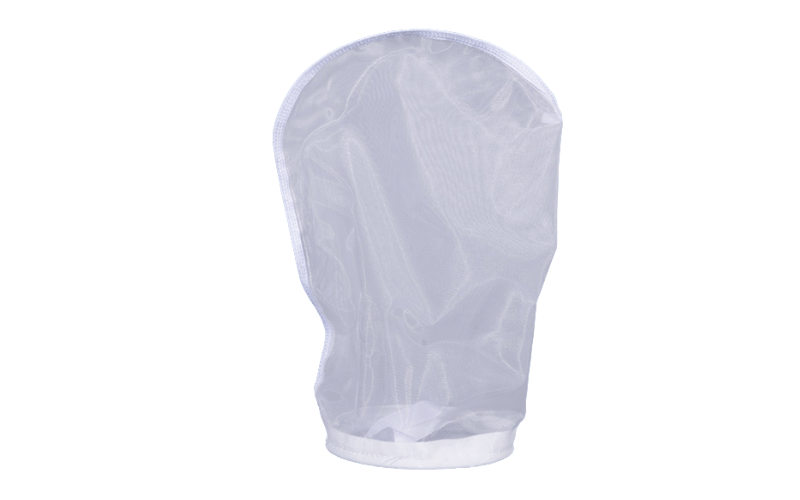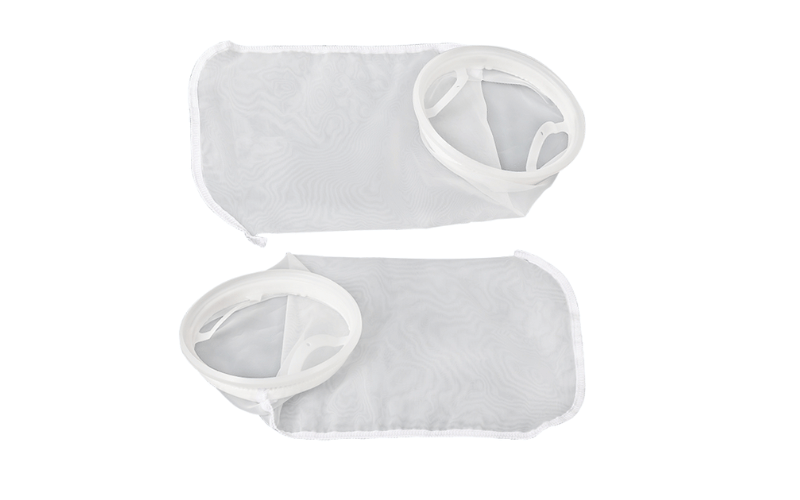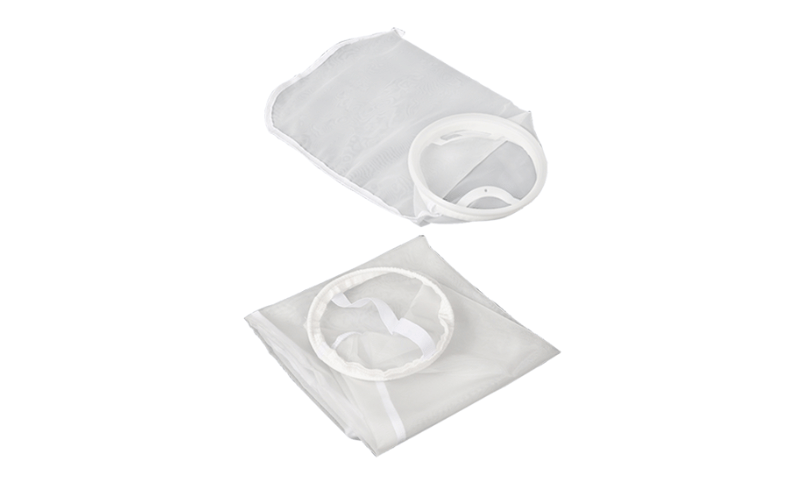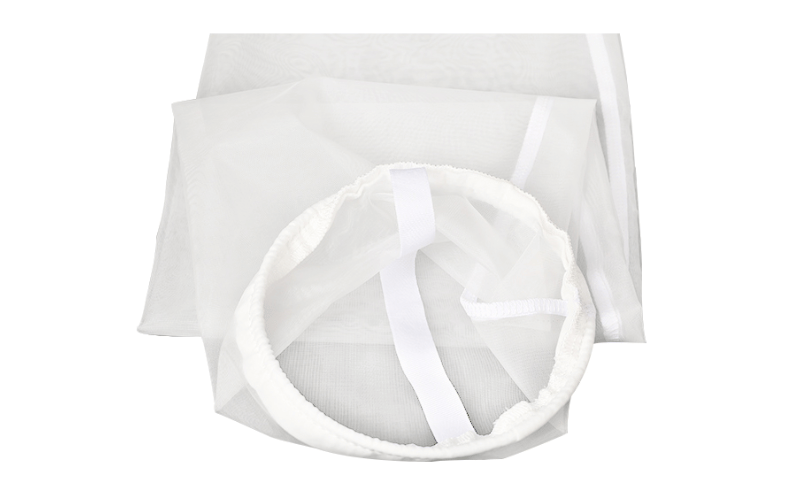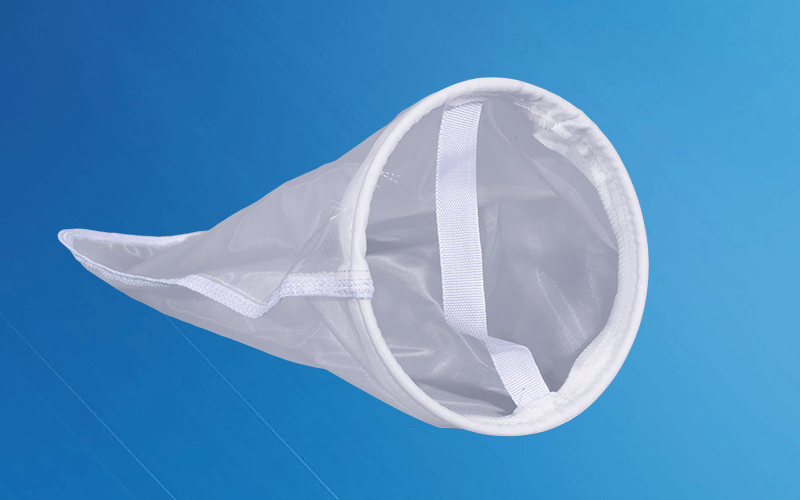Nylon Filter Bag
Home » Liquid Filter Bag » Nylon Filter Bag
Efficient Filtration | Long Service Life | Customizable Options
Our Nylon Filter Bags, also known as NMO Filter Bags, are engineered with industrial-standard monofilament mesh material, providing stable and reliable pore structures for precise filtration. Designed to filter hard particles, nylon is one of the most widely used materials in filtration applications due to its durability, chemical resistance, and precision.
At Top-filter Environmental Protection, we offer three specialized grades of nylon mesh bags, each tailored to specific industry needs:
- NLMO: Specially designed for the paint and ink industry, utilizing advanced processing techniques to capture free silica and oils.
- NLMP: Made from FDA-compliant nylon 66 material, ensuring safety for food and pharmaceutical applications.
- NLMB: Commonly used for general industrial applications to remove particulate impurities.
Our nylon filters undergo a heat-setting process to ensure that no loose fibers or extractables are present, thereby enhancing their quality. We also provide alternative materials, such as pure polypropylene (PPMO) and polyester monofilament mesh (PPME), to accommodate broader chemical compatibility needs.
Nylon Filter Bag Technical Parameters
| Parameter | Details |
|---|---|
| Material | Nylon |
| Specification | 1#, 2#, 3#, 4#, 5# |
| Filtration Precision | 25–1200 µm |
| General Use Temperature | <90°C |
| Manufacturing Process | Hot melt/seam |
| Ring Shape | Inside-out, outside-in, flat, steel ring |
| Bottom Shape | Rounded bottom, flat bottom |
Common Specifications
| Specification | #1 | #2 | #3 | #4 | #5 |
|---|---|---|---|---|---|
| Size (mm) | 180×430 | 180×810 | 105×230 | 105×380 | 150×560 |
| Flow (m³/h) | 20 | 40 | 6 | 12 | 20 |
| Filter Area (m²) | 0.24 | 0.48 | 0.08 | 0.16 | 0.24 |
| Volume (L) | 8 | 17 | 1.3 | 2.6 | 8 |

Products advantages
- Sealing Ring Options: Polypropylene, polyester SDS, STS, galvanized steel, or stainless steel.
- Sealing Ring Connection: Ultrasonic welding or thread sewing for durability and reliability.
- High Filtration Efficiency: Single-pass filtration efficiency of 98%.
- Heat-Set Surface Treatment: Prevents loose fibers and extractables for superior filtration quality.
- FDA Compliance: Meets stringent safety standards; free of silicone and other contaminants.
- Replacement Pressure: Designed for 0.10 MPa, with a maximum of 0.18 MPa.
- Wide Filtration Precision: Accommodates various filtration needs, ensuring versatility.
- High Flow Rate and Low Pressure Drop: Ensures efficient operations with minimal resistance.
- Broad Chemical Compatibility: Suitable for a wide range of industrial environments.
What Are the Benefits of Using Nylon Filter Bags?
Our nylon filter bags provide an exceptional combination of performance, durability, and versatility, making them an excellent choice for a variety of filtration needs. Made from high-quality nylon fibers, these bags are engineered for efficient and reliable filtration across numerous applications. Whether you need a solution for water treatment, food processing, or industrial processes, our nylon filter bags deliver consistent results.
Versatility Across Industries
One of the significant advantages of nylon filter bags is their adaptability. They can be used in diverse operational settings, including chemical processing, pharmaceuticals, and water filtration. The wide range of available micron ratings ensures that our nylon filter bags meet the specific requirements of different filtration processes with precision and reliability.
Reusability and Sustainability
Unlike some disposable filters, our nylon filter bags are designed for reusability. They can be cleaned and reused several times depending on the application, reducing waste and lowering the overall cost of filtration.
Efficiency of Nylon Filter Bags in Filtration
When it comes to filtration efficiency, nylon filter bags excel due to their unique material properties and construction. They are designed to remove solids effectively while maintaining high flow rates.
Precision Filtration
The availability of various micron ratings, ranging from coarse to fine filtration, allows our nylon filter bags to cater to a wide array of filtration needs. This ensures the effective removal of particulates without compromising the flow of liquid, making them highly efficient for both pre-filtration and final filtration processes.
Consistent Fluid Distribution
Our nylon filter bags ensure consistent fluid distribution across the filtration surface. This uniform distribution minimizes the risk of clogging and optimizes the filtration process, even in high-demand applications.
Durability and Strength of Nylon Monofilament
One of the standout features of our nylon filter bags is their robust design, particularly their use of monofilament fibers. This ensures long-lasting performance, even in demanding conditions.
High Mechanical Strength
Nylon monofilament materials are renowned for their strong mechanical properties. Our filter bags maintain their structural integrity under high-pressure conditions, ensuring reliable performance across various applications.
Abrasion and Chemical Resistance
Nylon’s resilience extends to its excellent resistance to abrasion and many chemicals. This makes our nylon filter bags particularly suitable for applications where the filtration media encounters harsh substances or high levels of wear and tear.
Longevity in Challenging Environments
The durability of nylon monofilament enables our filter bags to withstand repeated use and challenging operational conditions, extending the lifespan of the filtration system while maintaining its effectiveness.
Cost-Effectiveness Compared to Other Filter Materials
Our nylon filter bags not only deliver exceptional performance but also offer cost advantages, making them an economical choice for many industries.
Long-Term Savings
Thanks to their reusability and high-efficiency filtration, our nylon filter bags help reduce operational costs over time. Businesses benefit from fewer replacements and lower maintenance expenses, ultimately lowering the total cost of ownership.
Competitive Material Advantages
Compared to alternative filter materials, nylon offers a unique balance of cost, durability, and chemical compatibility. While some materials may excel in specific areas, nylon provides a well-rounded solution that meets diverse requirements without exceeding budget constraints.
Reduced Downtime
Given their robust construction and ease of cleaning, our nylon filter bags help minimize downtime associated with filtration system maintenance. With reliable performance and extended service life, they ensure higher operational efficiency for our customers.
By choosing our nylon filter bags, you’re investing in a filtration solution that combines efficiency, durability, and cost-effectiveness. If you’d like to learn more about our range of nylon filter bags or need assistance in selecting the right product for your applications, please feel free to contact us. We’re always here to help!
How to Choose the Right Size and Micron Rating for Your Filter Bag?
Selecting the correct size and micron rating for your filter bag is critical to achieving optimal filtration performance. At our company, we emphasize the importance of understanding these elements to ensure the best results for your specific application. Below, we’ll provide a detailed guide covering micron ratings, common sizes available for nylon filter bags, and the key factors to consider when making your selection.
Understanding Micron Ratings and Their Importance
When discussing filter bags, the micron rating indicates the size of particles the filter can effectively capture. One micron equals one-millionth of a meter, and micron ratings typically range from 1 micron (extremely fine filtration) to 200 microns (coarser filtration). Here’s why understanding micron ratings is essential:
1. Particle Size Control
The micron rating determines the particle size that the filter bag can trap. For example, a 10-micron filter bag will capture particles that are 10 microns in diameter or larger, while smaller particles will pass through. This precision ensures that only unwanted contaminants are removed from your process fluids.
2. Application-Specific Requirements
Different industries and applications require specific filtration grades. For instance, the pharmaceutical industry often demands fine filtration, such as 1- or 5-micron ratings, to ensure product purity. On the other hand, applications like industrial water treatment may focus on removing larger particles, making higher micron ratings more suitable.
3. System Performance
Choosing a micron rating too fine for your system may lead to reduced flow rates and higher pressure drops, whereas a rating that is too coarse might fail to meet your filtration objectives. Striking a balance is key to maintaining consistency and efficiency.
4. Impact on Filtration Longevity
The smaller the micron rating, the faster the filter bag may become clogged with debris, requiring more frequent replacements. By understanding the relationship between micron ratings and your application’s needs, you can optimize both performance and cost-effectiveness.
Common Sizes for Nylon Filter Bags
Filter bag sizes are standardized to accommodate various filtration systems and applications. Our nylon filter bags are available in a range of sizes to ensure compatibility with both industrial and commercial setups. The following are the most common sizes for nylon filter bags:
1. Size 1 (7″ x 16″)
Ideal for smaller systems, Size 1 filter bags are compact yet effective. Despite their size, they have considerable filtration capacity, making them suitable for applications with moderate flow rates and contaminant loads.
2. Size 2 (7″ x 32″)
The most popular choice in many industries, Size 2 bags offer extended length for greater dirt-holding capacity. These are commonly used in high-volume systems or where more frequent replacements would disrupt workflows.
3. Size 3 (4″ x 8.25″)
Smaller than Size 1 bags, Size 3 is often used for low-flow systems or where space constraints are a concern. These are typically ideal for smaller-scale applications or customized filtration solutions.
4. Size 4 (4″ x 14″)
Slightly longer than Size 3 bags, Size 4 bags provide a balance between compact design and increased filtration capacity. They are well-suited for moderate flow rates and systems with tight installation spaces.
5. Custom Sizes
For applications with unique requirements, we also offer custom-sized filter bags. Customization ensures that the bag fits seamlessly into your existing system while meeting specific filtration goals.
Our nylon filter bags come with various sealing ring options, including polypropylene, galvanized steel, and stainless steel, providing you with additional flexibility when choosing the appropriate size.
Factors to Consider When Selecting Size and Rating
Choosing the right filter bag entails evaluating several critical factors to align with your application’s performance demands. Here’s what you should consider:
1. Flow Rate Requirements
The system’s flow rate directly impacts the type of filter bag you’ll need. Higher flow rates typically require larger filter bags (e.g., Size 2), as they can process larger volumes of liquid without clogging prematurely. Pairing the flow rate with the microns needed enables optimal system performance.
2. Type of Contaminants
Consider the nature and size of the impurities that need to be filtered. Applications such as paint production or ink processing may require fine filtration to capture micro-particles, whereas general industrial use may only need coarser filtration to remove larger debris.
3. System Pressure and Drop
It’s essential to assess the pressure differential in your system. Filters with finer micron ratings may create higher pressure drops, potentially reducing overall flow efficiency. Balancing micron ratings and system performance avoids operational disruptions.
4. Chemical Compatibility
Evaluate the compatibility of the bag material with the liquid being filtered. Nylon filter bags excel in several industrial applications but may not be suitable for extremely acidic or high-temperature environments. For such cases, alternative materials like polypropylene or polyester filter bags might be more appropriate.
5. Regulatory Compliance
Industries like food and pharmaceuticals require materials that meet stringent regulatory standards. Our NLMP nylon filter bags, for example, are FDA-compliant, making them ideal for applications requiring adherence to safety and hygiene protocols.
6. Operating Environment
Consider external factors such as temperature, system operating conditions, and space availability. This ensures that both the size and material of the filter bag are suitably matched to the application’s environmental requirements.
7. Economy and Longevity
Finally, it’s important to balance quality and cost. A well-matched filter bag will reduce the frequency of replacements, saving on operational downtime and long-term expenses. Our high-quality nylon filter bags, with their durable monofilament construction and heat-set treatment, are designed to provide cost-effective and reliable filtration.
Final Thoughts
Selecting the right size and micron rating for your filter bag involves a careful analysis of your application’s unique requirements. By understanding micron ratings, choosing appropriate sizes, and considering factors such as flow rate, contaminant type, and regulatory needs, you can ensure the efficiency and longevity of your filtration system.
We are committed to helping you make informed decisions when choosing the best filtration solutions for your operations. If you have any questions or need personalized assistance, contact our team today—we’re here to guide you every step of the way.
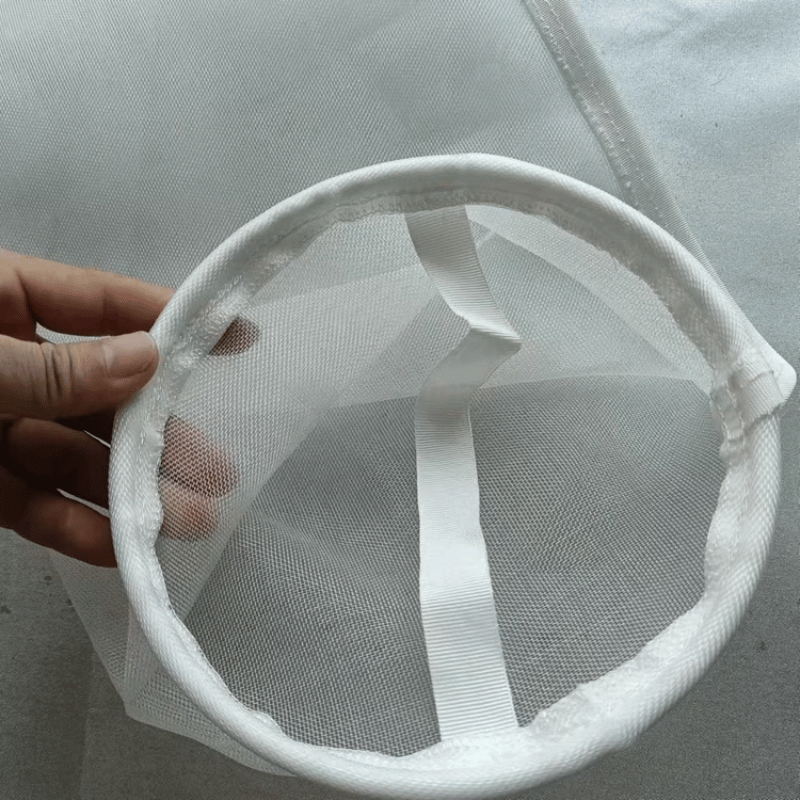
Comparing Nylon Filter Bags to Other Filter Media
When choosing the right filtration solution, understanding the differences between filter media is crucial for achieving optimal performance. At our company, we prioritize educating our customers so that they can make informed decisions based on their specific application needs. Nylon filter bags, renowned for their strength, flexibility, and chemical compatibility, are a popular choice across various industries. Here, we’ll provide a comprehensive comparison of nylon and other filter media types, exploring their advantages and applications. We’ll also discuss key considerations when selecting the best option for your system.
Nylon vs. Polyester: Which is Better?
Nylon and polyester are two of the most commonly used materials in filter bag manufacturing. While both offer certain advantages, their performance varies depending on the application. Below, we’ll outline the primary differences to help you determine which material is better suited to your needs.
1. Material Composition and Durability
Nylon is a synthetic polymer that offers excellent flexibility and resilience. Its unique molecular structure makes it stretchable without cracking or breaking, delivering outstanding durability for demanding filtration tasks. Polyester, on the other hand, is also a synthetic polymer but tends to be stiffer, which can limit its flexibility in certain applications.
- Nylon Advantage: Ideal for applications that require pliability and durability under stress, such as painting and ink processing systems.
- Polyester Advantage: Sturdier and better-suited for applications where rigidity is preferred, such as high-pressure environments.
2. Chemical Resistance
When it comes to chemical compatibility, both nylon and polyester perform well, but they excel in different environments.
- Nylon tolerates alkalis effectively but has reduced resistance to strong acids and oxidizing agents, such as bleach. It also absorbs moisture, which may affect its performance in humid environments.
- Polyester offers superior resistance to acids and performs better in environments with higher humidity levels, as it doesn’t absorb water like nylon does.
3. Temperature Stability
Operating temperature is another critical factor. Nylon is suitable for temperatures up to approximately 120°C (248°F), whereas polyester offers slightly higher heat resistance, around 150°C (302°F). For high-temperature processes, polyester may be a better choice.
4. Applications
- Nylon excels in refined filtration tasks that require capturing fine particles with high precision, for example, the food and pharmaceutical industries.
- Polyester is preferred in environments where high resistance to distortion under heat and pressure is critical, such as chemical manufacturing and high-temperature fluid filtration.
Both materials offer excellent performance, but the choice depends on the contaminants being filtered, the operating environment, and the type of filtration system.
Advantages of Monofilament Mesh Over Felt Filters
When comparing filter bag construction types, monofilament mesh and felt filters are two prominent options. Each has its unique properties, but monofilament mesh offers several advantages in terms of precision, reusability, and contamination control.
1. Filtration Efficiency
Monofilament mesh consists of uniformly woven synthetic fibers with precise pore sizes. This configuration ensures consistent and predictable filtration, making it ideal for applications requiring exact particle capture, such as paint processes or water treatment.
- Advantage: Monofilament mesh provides precise pore openings, minimizing the risk of bypass or inconsistent filtration quality, whereas felt filters often rely on a thicker, less uniform structure for particle capture.
2. Ease of Cleaning and Maintenance
Monofilament mesh is easier to clean compared to felt filters. The smooth surface of monofilament mesh allows trapped particles to be rinsed off more effectively, while felt filters tend to embed contaminants deep within the material, making cleaning more challenging.
- Advantage: Reusability of monofilament mesh reduces maintenance costs over time. Felt filters often require replacement after clogging.
3. Durability
The tightly woven structure of monofilament mesh makes it highly durable, capable of withstanding repeated use without degradation. Felt filters, though robust, are more prone to wear and tear due to their non-woven design.
- Advantage: Monofilament mesh is more resistant to physical stress and offers a longer lifespan.
4. Applications
Felt filters perform well in applications requiring depth filtration, where both large and fine particles need to be trapped within the material. Monofilament mesh, however, is preferable in applications needing surface filtration for precise particle separation.
For industries needing reliable, high-precision filtration, monofilament mesh offers clear advantages over felt filters. Its durability, ease of cleaning, and consistent filtration performance make it a superior choice for many applications.
Choosing Between Different Mesh Weaves
Monofilament mesh filter bags are available in a variety of weave patterns, allowing for customization based on specific filtration needs. The choice of mesh weave can significantly influence filtration performance, pressure drop, and dirt-holding capacity. Here’s what to consider:
1. Plain Weave
This is the most common weave type, characterized by a crisscross pattern where the warp and weft fibers intersect at regular intervals. Plain weave provides uniform pore openings and is widely used for general filtration tasks.
- Advantage: Simple, cost-effective, and provides consistent filtration for particles down to the micron level.
2. Twill Weave
Twill weave involves a staggered fiber arrangement, creating a diagonal rib pattern. This weave is stronger and more flexible compared to plain weave.
- Advantage: Enhanced durability and resilience make it suitable for high-pressure systems or applications with continuous flow variability.
3. Dutch Weave
Dutch weave involves combining fine weft threads with thicker warp threads, resulting in a tighter weave with smaller pore sizes. This maximizes filtration density while maintaining physical strength.
- Advantage: Exceptional for applications requiring ultra-fine filtration, such as pharmaceutical production or microfiltration systems.
4. Reverse Dutch Weave
Reverse Dutch weave reverses the roles of the warp and weft threads (thicker weft and thinner warp) for greater flow rates without compromising filtration efficiency.
- Advantage: Ideal for industries that require high throughput combined with fine filtration, such as water treatment plants.
Final Thoughts
Choosing the right filter media is integral to the success of your filtration system. Whether comparing nylon and polyester, deciding between monofilament mesh and felt, or selecting the most effective weave pattern, each decision should align with your unique application requirements. Our team is here to guide you in making tailored choices that enhance your system’s performance. Contact us today for expert guidance on selecting the ideal filtration solution for your process.
How to Maintain and Clean Your Nylon Filter Bags?
Proper maintenance and cleaning of nylon filter bags are essential for ensuring their efficiency and longevity. At our company, we recognize that well-kept filter bags not only improve filtration performance but also reduce operational costs by extending product life. Below, we’ll outline best practices for cleaning, maintaining, and knowing when it’s time to replace your nylon filter bags. By following these guidelines, you can optimize the performance of your filtration systems.
Best Practices for Cleaning Nylon Filter Bags
Cleaning nylon filter bags effectively requires care to prevent damage while ensuring that contaminants are thoroughly removed. Here is a step-by-step guide to cleaning your filter bags:
1. Remove the Filter Bag with Care
Before cleaning, it’s essential to carefully remove the filter bag from its housing to avoid punctures or accidental tears. Inspect the sealing ring and seams for any signs of damage during the removal process.
2. Shake Off Loose Debris
Gently shake the filter bag to remove loose debris and larger particles that have become caught on its surface. This step minimizes the buildup of contaminants during the cleaning process and ensures better cleaning results.
3. Choose the Right Cleaning Method
There are two primary cleaning methods for nylon filter bags, depending on the level and type of contamination:
- Rinsing with Water
- For lightly soiled filter bags, rinsing with clean water is often sufficient. Use cold or lukewarm water to rinse the bag inside out. Avoid using water that is excessively hot, as this may warp the nylon material.
- Chemical Washing
- For filter bags used in applications with oil residues or chemical contaminants, soak the bag in a cleaning solution that is compatible with nylon. We recommend using a non-abrasive, pH-neutral detergent to prevent damage to the material. Always ensure the cleaning solution is thoroughly rinsed out post-cleaning.
4. Avoid Harsh Cleaning Tools
When manually scrubbing the filter bag, use only soft brushes or sponges to gently clean stubborn residues. Metal brushes, scouring pads, or abrasive tools should be avoided as they risk damaging the bag’s monofilament structure and reducing filtration efficiency.
5. Air Dry Completely
Once cleaned, hang the nylon filter bag in a clean, well-ventilated area to air dry. Ensure it is scorched before reinstallation to prevent mold formation or bacterial growth within the bag. Avoid using direct heat sources like dryers, as these can cause material warping or shrinkage.
By following these cleaning steps regularly, you can preserve the integrity and performance of your nylon filter bags.
How to Extend the Life of Your Filter Bag
Nylon filter bags are designed for long-term use; however, improper handling or maintenance can significantly reduce their lifespan. Here are key practices to maximize their longevity:
1. Adhere to Recommended Pressure Limits
Operating your filter bag at pressures exceeding the recommended limits may lead to material stress and premature failure. Our nylon filter bags are designed for optimal performance at 0.10 MPa, with a maximum pressure threshold of 0.18 MPa. Regularly monitor your system’s pressure to ensure these limits are not exceeded.
2. Avoid Overloading
Overloading the filter bag with excessive contaminants can cause clogging and reduce its effectiveness. Ensure that your system is designed with appropriate flow rates and dirt-holding capacity to suit your specific application. When high contaminant loads are present, consider using pre-filters to reduce the burden on your main filter bags.
3. Perform Regular Inspections
Conduct routine checks to identify wear and tear, such as fraying around seams, stretched material, or damage to the sealing ring. Addressing minor issues early can prevent more significant failures and costly downtime.
4. Rotate Filter Bags
If your filtration system allows it, use multiple filter bags in rotation to ensure optimal filtration. This approach minimizes wear and tear on individual bags by spreading usage evenly across various units.
5. Store Properly
Store unused nylon filter bags in a clean, dry environment away from direct sunlight and chemicals that may degrade the material. Proper storage conditions help maintain the bag’s structural integrity and enhance its shelf life.
When to Replace Your Nylon Filter Bag
While regular cleaning and proper maintenance can extend the life of your nylon filter bags, they will eventually reach the end of their usable lifespan. Here’s how to determine when it’s time for a replacement:
1. Decreased Filtration Efficiency
Suppose the filter bag no longer captures contaminants as effectively as before, even after thorough cleaning. In that case, it may indicate that the material has worn down or the pore structure has become compromised.
2. Persistent Clogs
Frequent clogging, despite routine cleaning, is a sign that the bag’s capacity to hold contaminants has been reduced. Over time, the microscopic pore openings may become obstructed or damaged.
3. Visible Damage
Inspect the filter bag for rips, tears, or any deformation in the material. Damage to the sealing ring, such as cracks or warping, can lead to leaks and compromised filtration. Any visible flaws necessitate replacement to avoid system inefficiency.
4. Excessive Pressure Drops
A sustained increase in system pressure, even with a cleaned filter bag, suggests that the bag has exceeded its optimal operating life. This often indicates that the material has thickened or hardened due to prolonged use, restricting flow.
5. Industry-Specific Compliance
Specific applications, such as food and pharmaceutical production, require the replacement of filter bags at regular intervals to maintain compliance with hygiene and safety regulations. Adhering to these replacement schedules is crucial to meeting industry standards.
By recognizing these warning signs and replacing your filter bags proactively, you can maintain consistent filtration quality and avoid unexpected system failures.
Final Thoughts
Maintaining and cleaning your nylon filter bags is a straightforward yet essential step in ensuring their longevity and optimal performance. By adhering to best cleaning practices, taking measures to extend product life, and replacing bags when necessary, you can safeguard your filtration system’s efficiency and reliability. If you have additional questions or need assistance selecting the right filters for your application, don’t hesitate to reach out to our team. We’re here to support you in achieving the highest standards of filtration performance.
FAQs About Nylon Filter Bag
Q: What is a nylon filter bag?
A: A nylon filter bag is a type of product designed to strain liquids or solids using nylon mesh. These mesh filter bags are often used in various applications, including industrial processes and home brewing.
Q: What are the benefits of using nylon mesh for filter bags?
A: Nylon mesh offers several advantages, including excellent strength, durability, and superior dirt release compared to felt media. The woven construction from single-fiber threads ensures a uniform mesh that can accommodate high flow rates.
Q: How can I clean my nylon filter bag?
A: Nylon filter bags are easy to clean. They can typically be rinsed with water and mild soap, making them reusable and cost-effective. Ensuring that the bag is completely dry before storage will help maintain its quality.
Q: What micron rating is common for nylon filter bags?
A: Nylon filter bags often come in various micron ratings, with 100 micron being a common option. This rating is suitable for many filtration applications, providing a balance between flow rates and the ability to strain particles effectively.
Q: Are nylon filter bags compatible with different liquids?
A: Yes, nylon filter bags are compatible with a wide range of liquids, making them versatile for various applications. Their construction provides excellent chemical resistance, allowing for effective filtration of different substances.
Q: What features should I look for in a quality nylon filter bag?
A: When selecting a quality nylon filter bag, consider features such as the mesh type (nylon monofilament mesh), opening style (drawstring or flange), durability, and ease of cleaning. These factors contribute to the overall performance and usability of the product.
Q: How do nylon filter bags compare to other types of filter bags?
A: Nylon filter bags generally offer stronger performance and superior dirt release compared to felt media. Their nylon mesh construction allows for higher flow rates and more effective filtration, making them a preferred choice in many applications.
Q: Can nylon filter bags be used for solid filtration?
A: Yes, nylon filter bags can effectively strain solids from liquids, making them suitable for applications such as brewing, cooking, and industrial processes where solid-liquid separation is required.
Q: What is the typical construction of a nylon filter bag?
A: A nylon filter bag is typically constructed from woven nylon mesh, which is designed to provide excellent strength and durability. This construction allows for effective filtration while maintaining a lightweight and easy-to-handle design.


